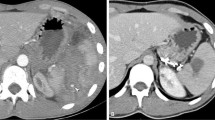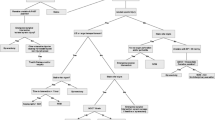Abstract
The objective of our study was to evaluate the role of splenic artery embolization (SAE) in the management of traumatic splenic injuries. From September 2008 to September 2010, a total of 67 patients underwent nonoperative management (NOM) for blunt splenic injuries. Twenty-two patients were excluded from the study because of associated significant other organ injuries. Twenty-five patients underwent SAE followed by NOM (group A) and 20 patients underwent standard NOM (group B). Improvement in clinical and laboratory parameters during hospital stay were compared between two groups using Chi-square test and Mann–Whitney test. SAE was always technically feasible. The mean length of the total hospital stay was lower in the group A patients (5.4 vs. 6.6 day, [P = 0.050]). There was significant increase in hemoglobin and hematocrit levels and systolic blood pressure (SBP) in group A patients after SAE, whereas in group B patients there was decrease in hemoglobin and hematocrit levels and only slight increase in SBP (pre- and early posttreatment relative change in hemoglobin [P = 0.002], hematocrit [P = 0.001], and SBP [P = 0.017]). Secondary splenectomy rate was lower in group A (4 % [1/25] vs. 15 % [3/20] [P = 0.309]). No procedure-related complications were encountered during the hospital stay and follow-up. Minor complications of pleural effusion, fever, pain, and insignificant splenic infarct noted in 9 (36 %) patients. SAE is a technically feasible, safe, and effective method in the management of splenic injuries. Use of SAE as an adjunct to NOM of splenic injuries results improvement in hemoglobin, hematocrit levels, and SBP. SAE also reduces secondary splenectomy rate and hospital stay.



Similar content being viewed by others
References
Bessoud B, Denys A, Calmes JM et al (2006) Nonoperative management of traumatic splenic injuries: is there a role for proximal splenic artery embolization? AJR Am J Roentgenol 186:779–785
Pachter H, Guth A, Hofstetter S, Spencer F (1998) Changing patterns in the management of splenic trauma: the impact of nonoperative management. Ann Surg 227:708–717
Velmahos G, Chan L, Kamel E et al (2000) Nonoperative management of splenic injuries: have we gone too far? Arch Surg 135:674–679
Brasel K, DeLisle C, Olson C, Borgstrom D et al (1998) Splenic injury: trends in evaluation and management. J Trauma 44:283–286
Wei B, Hemmila MR, Arbabi S et al (2010) Angioembolization reduces operative intervention for blunt splenic injury. World J Surg 34(11):2745–2751
Federle M, Courcoulas A, Powell M, Ferris J, Peitzman A (1998) Blunt splenic injury in adults: clinical and CT criteria for management, with emphasis on active extravasation. Radiology 206:137–142
Velmahos G, Toutouzas K, Radin R, Cjan L, Demetriades D (2003) Nonoperative treatment of blunt injury to solid abdominal organs. J Trauma 138:844–851
Shapiro M, Krausz C, Durham R, Mazuski J (1999) Overuse of splenic scoring and computed tomographic scans. J Trauma 47:651–658
Haan J, Scott J, Boyd-Kranis R, Ho S, Kramer M, Scalea T (2001) Admission angiography for blunt splenic injury: advantages and pitfalls. J Trauma 51:1161–1165
Moore E, Cogbill T, Jurkovich G, Shackford S, Malangoni M, Champion H (1995) Organ injury scaling: spleen and liver (1994 revision). J Trauma 38:323–324
Sclafani S, Weisberg A, Scalea T, Phillips T, Duncan A (1991) Blunt splenic injuries: nonsurgical treatment with CT, arteriography, and transcatheter arterial embolization of the splenic artery. Radiology 181:189–196
Hagiwara A, Yukioka T, Ohta S, Nitatori T, Matsuda H, Shimazaki S (1996) Nonsurgical management of patients with blunt splenic injury: efficacy of transcatheter arterial embolization. AJR 167:159–166
Sclafani S, Shaftan G, Scalea T et al (1995) Nonoperative salvage of computed tomography–diagnosed splenic injuries: utilization of angiography for triage and embolization for hemostasis. J Trauma 39:818–825
Keramidas D, Buyukunal C, Senyuz O, Dolatzas T (1991) Splenic artery ligation: a ten-year experience in the treatment of selected cases of splenic injuries in children. Jpn J Surg 21:172–177
Bessoud B, Denys A (2004) Main splenic artery embolization using coils in blunt splenic injuries: effects on the intrasplenic blood pressure. Eur Radiol 14:1718–1719
Keramidas D, Kelekis D, Dolatzas T, Aivazoglou T, Voyatzis N (1984) The collateral arterial network of the spleen following ligation of the splenic artery in traumatic rupture of the spleen: an arteriographic study. Z Kinderchir 39:50–51
Killeen K, Shanmuganathan K, Boyd-Kranis R, Scalea T, Mirvis S (2001) CT findings after embolization for blunt splenic trauma. J Vasc Interv Radiol 12:209–214
Haan J, Ilahi O, Kramer M, Scalea T, Myers J (2003) Protocol-driven nonoperative management in patients with blunt splenic trauma and minimal associated injury decreases length of stay. J Trauma 55:317–321
Haan J, Biffl W, Knudson M et al (2004) Splenic embolization revisited: a multicenter review. J Trauma 56:542–547
Haan JM, Bochicchio GV, Kramer N et al (2005) Nonoperative management of blunt splenic injury: a 5-year experience. J Trauma 58:492–498
Davis KA, Fabian TC, Croce MA et al (1998) Improved success in nonoperative management of blunt splenic injuries: embolization of splenic artery pseudoaneurysms. J Trauma 44:1008–1013
Liu PP, Lee WC, Cheng YF et al (2004) Use of splenic artery embolization as an adjunct to nonsurgical management of blunt splenic injury. J Trauma 56:768–772, discussion 773
Dent D, Alsabrook G, Erickson BA et al (2004) Blunt splenic injuries: high nonoperative management rate can be achieved with selective embolization. J Trauma 56:1063
Smith HE, Biffl WL, Majercik SD et al (2006) Splenic artery embolization: have we gone too far? J Trauma 61:541–544, discussion 545–546
Peitzman A, Heil B, Rivera L et al (2000) Blunt splenic injury in adults: multi-institutional Study of the Eastern Association for the Surgery of Trauma. J Trauma 49:177–187
Raikhlin A, Baerlocher MO, Asch MR et al (2008) Imaging and transcatheter arterial embolization for traumatic splenic injuries: review of the literature. J Can Chir 51(6):464–472
Schnüriger B, Inaba K, Konstantinidis A et al (2011) Outcomes of proximal versus distal splenic artery embolization after trauma: a systematic review and meta-analysis. J Trauma 70(1):252–260
Mayglothling JA, Haan JM, Scalea TM et al (2011) Blunt splenic injuries in the adolescent trauma population: the role of angiography and embolization. J Emerg Med 41(1):21–28, Epub 2009 Jan 31
Duchesne JC, Simmons JD, Schmieg RE Jr, McSwain NE Jr et al (2008) Proximal splenic angioembolization does not improve outcomes in treating blunt splenic injuries compared with splenectomy: a cohort analysis. J Trauma 65(6):1346–1353
Funding
None
Author information
Authors and Affiliations
Corresponding author
Rights and permissions
About this article
Cite this article
Parihar, M.L., Kumar, A., Gamanagatti, S. et al. Role of Splenic Artery Embolization in Management of Traumatic Splenic Injuries: A Prospective Study. Indian J Surg 75, 361–367 (2013). https://doi.org/10.1007/s12262-012-0505-9
Received:
Accepted:
Published:
Issue Date:
DOI: https://doi.org/10.1007/s12262-012-0505-9




